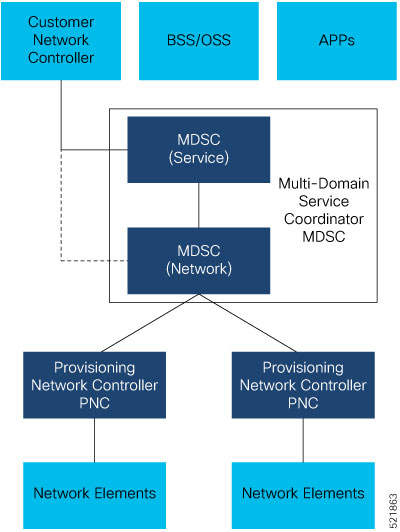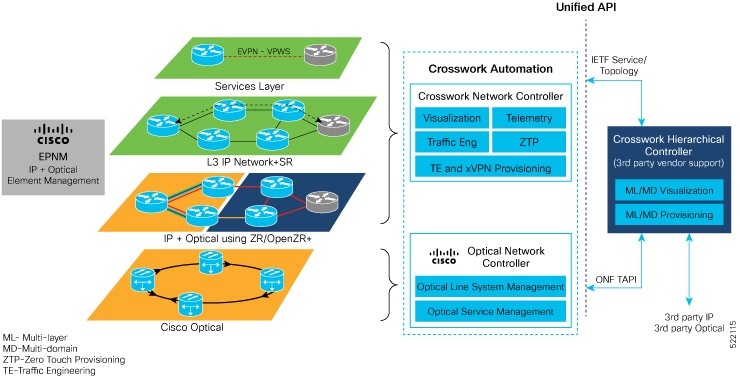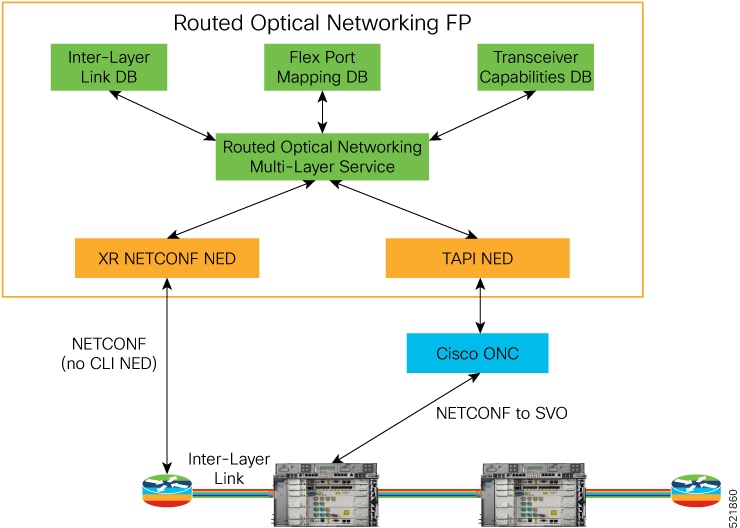Hardware Components
The hardware components that enable Routed Optical Networking are:
-
High Density Routers
-
High Capacity Pluggable Optical Modules
-
Optical Line Systems
Cisco 8000 Series Routers
The Cisco 8000 series routers utilize Cisco's Silicon One ASIC to deliver full routing functionality at higher capacities and a lower environmental footprint than any other routing silicon available. The Silicon One architecture supports large forwarding tables, deep buffers, flexible packet operations, and enhanced programmability.
The 8000 series are highly scalable, deep-bufferred, 100G/400G/800G optimized routers. They are also available with additional on-chip High Bandwidth Memory (HBM) to support additional resource scale. The Cisco 8000 series routers support both ZR and ZR+ modules.
Cisco 8200 Series Routers
The Cisco 8200 Series uses a single Cisco Silicon One ASIC to deliver full routing functionality. The Cisco 8200 Series is designed for relatively high-buffer and high-scale use cases. These fixed port, high-density routers provide 10.8 Tbps of network bandwidth with dramatically lower power consumption than contemporary 10 Tbps systems.
This table details the specifications of the routers.
| Router | Capacity | Form factor | 400G QSFP-DD Ports | 100G QSFP28 Ports |
|---|---|---|---|---|
| Cisco 8201 | 10.8 Tbps | 1 RU | 24 | 12 |
| Cisco 8202 | 10.8 Tbps | 2 RU | 12 | 60 |
| Cisco 8201-32FH | 12.8 Tbps | 1 RU |
32 |
– |
|
Cisco 8202-32FH-M |
12.8 Tbps | 2 RU |
32 |
– |
|
Cisco 8201-24H8FH |
5.6 Tbps | 1 RU |
8 |
24 |
Cisco 8800 Series Routers
The Cisco 8800 Series delivers density and efficiency with the extensive scale, buffering, and all feature capabilities that are common to Cisco 8000 Series routers. The 8800 series routers provide up to approximately 260 Tbps through 648 400 GbE ports. The 8800 series includes four chassis to meet a broad set of network and facility requirements.
This table details the specifications of the routers.
| Router | Capacity | Form factor | 400G QSFP-DD Ports |
|---|---|---|---|
| Cisco 8804 | Up to 57.6 Tbps | 4-slot/10 RU |
Up to 144 |
| Cisco 8808 | Up to 115.2 Tbps | 8-slot/16 RU |
Up to 288 |
| Cisco 8812 | Up to 172.8 Tbps | 12-slot/21 RU |
Up to 432 |
| Cisco 8818 | Up to 259.2 Tbps | 18-slot/33 RU |
Up to 648 |
Cisco 8800 Series Line Cards
The Cisco 8800 Series modular platform supports 400 GbE line cards.
This table details the specifications of the line cards.
| Line Cards | Bandwidth | 400G QSFP-DD Ports |
|---|---|---|
| 8800-LC-36FH | 14.4 Tbps | 36 |
| 88-LC0-36FH-M | 14.4 Tbps | 36 |
| 88-LC0-36FH | 14.4 Tbps | 36 |
For information on ZR/ZR+ port support, see 400G ZR/ZR+ Transceivers.
For more information about Cisco 8000 Series Routers, see the Cisco 8000 Series Routers Data Sheet.
Cisco Network Convergence System 5500 Series
The Network Convergence System (NCS) 5500 platform offers high port density, high-performance forwarding, low jitter, and low power consumption.
Cisco NCS-57B1 Series Fixed Port Routers
The NCS-57B1-6D24-SYS and NCS-57B1-5DSE-SYS combine 4.8 Terabits of 400GE/100GE optimized forwarding capacity, QSFP-DD optics, deep packet buffering, full line-rate MACsec, Class C 1588 Precision Time Protocol (PTP), and Synchronous Ethernet (SyncE) in a power-efficient, 1-rack-unit package.
This table details the specifications of the routers.
| Router | Capacity | Form factor | 400G QSFP-DD Ports | 100G QSFP-DD Ports |
|---|---|---|---|---|
| NCS-57B1-6D24-SYS | Up to 4.8 Tbps | 1 RU | 6 | 24 |
| NCS-57B1-5DSE-SYS | Up to 4.4 Tbps | 1 RU | 5 | 24 |
For more information about Cisco NCS-57B1 Series Fixed Port Routers, see the Cisco Network Convergence System 5700 Series: NCS-57B1 Fixed Chassis Data Sheet.
Cisco NCS 5500 Modular Chassis
The Cisco NCS 5500 modular chassis series is available in three system sizes: NCS 5504, NCS 5508, NCS 5516. All NCS systems are highly reliable and resilient platforms. They support a wide range of line card options. NCS 5500 modular router line cards and fabric modules directly attach to each other with connecting pins. In contrast, most traditional modular platform designs require a midplane.
This table details the specifications of the routers.
| Platform | Capacity | Form factor | 400G QSFP-DD Ports | 100G QSFP28 Ports |
| NCS 5504 | Up to 14.4 Tbps | 4-Slot / 7 RU | Up to 96 | Up to 144 |
| NCS 5508 | Up to 76.8 Tbps | 8-Slot / 13 RU | Up to 192 | Up to 288 |
| NCS 5516 | Up to 153.6 Tbps | 16-Slot / 21 RU | Up to 384 | Up to 576 |
For more information about Cisco Network Convergence System 5500 Series Modular Chassis, see the Cisco Network Convergence System 5500 Series Modular Chassis Data Sheet.
NCS 5700 Series Line Cards
NCS 5700 series line cards are 400G line cards for the NCS 5500 Series modular chassis. NCS 5700 series line cards consists of two versions of 400GE optimized line cards: the base version and the scale version. The two 400GE optimized line cards in the NCS5700 series are NC57-24DD and NC57-18DD-SE.
For information on ZR/ZR+ port support, see 400G ZR/ZR+ Transceivers.
For more information about Cisco Network Convergence System 5700 Series 400GE, see the Cisco Network Convergence System 5700 Series: 400GE and 100GE Line Cards Data Sheet.
400G ZR/ZR+ Transceivers
The QDD-400G-ZR-S and QDD-400G-ZRP-S optical modules offload wavelength-division multiplexing (WDM) functionality to the router. The QDD-400G-ZR-S and QDD-400G-ZRP-S optical modules are DWDM C-band (196.1 to 191.3 THz with 100-MHz spacing) tunable optical modules. These optical modules enable high-bandwidth 400G links and support 400G Ethernet rate.
This table lists some specifications of the ZR/ZR+ pluggable modules.
| Parameter | QDD-400G-ZR-S | QDD-400G-ZRP-S |
|---|---|---|
| Client Speed | 400G, 4x100G | 400G, 4x100G, 3x100G, 2x100G, 1x100G |
| Trunk Speed | 400G | 400G, 300G, 200G, 100G |
| FEC | cFEC | oFEC, cFEC |
| Modulation | 16-QAM | 16-QAM, 8QAM, QPSK |
| Frequency | C-Band, 196.1 To 191.3 THz | C-Band, 196.1 To 191.3 THz |
The ZR/ZR+ pluggable optical modules are based on the QSFP-DD form factor. This form factor is a universal standard and ensures interoperability with other vendors.
For more information on Cisco 400G Digital Coherent Optics QSFP-DD Optical Modules, see the Cisco 400G Digital Coherent Optics QSFP-DD Optical Modules Data Sheet.
Device Supported Software
This table shows the IOS XR Software necessary on the routers.
| Product | 400G ZR | 400G ZR+ |
|---|---|---|
| Cisco 8000 Series | 7.3.2 | 7.3.2 |
| Cisco NCS 5500 Series | 7.3.2 | 7.3.2 |
|
Cisco ASR 9000 Series |
7.3.2 | 7.3.2 |
|
Cisco NCS 540 Series |
7.4.1 | 7.4.1 |
This table shows the required IOS XR Software version on the routers to support specific breakout modes.
The following table shows the required IOS XR Software version on the routers to support specific breakout modes on Bright ZR+ pluggable optical modules.
Cisco Network Convergence System 2000 Series
The Cisco Network Convergence System 2000 Series delivers agility, programmability, and massive scale across ultra-long haul, metro, and enterprise optical networks. Using the Cisco NCS 2000 Series, you can deploy a simple, yet intelligent dense wavelength-division multiplexing (DWDM) network that scales with operational ease. The NCS 2000 devices are managed by Shelf Virtualization Orchestrator (SVO).
Cisco NCS 2006 Shelf
The NCS 2006 shelf has eight horizontal cardslots. The Cisco NCS 2006 chassis is 6 RU and has six slots for service cards and two slots for controller cards. It supports multishelf management up of to 50 shelves.
For more information on Cisco Network Convergence System 2000 Series, see the Cisco Network Convergence System 2000 Series Data Sheet.
Shelf Virtualization Orchestrator
Cisco NCS 2000 Shelf Virtualization Orchestrator (SVO) introduces programmability of optical network elements and automation with NETCONF interface and YANG models. SVO enables end-to-end, software-defined automated networks that maximize revenue to customers and ease the network turn-up, operation, and maintenance.
SVO is available with a server on a blade encasing a high-speed processor with virtualized instances of multiple reconfigurable optical add/drop multiplexer (ROADM), optical line amplifier (OLA), and dynamic gain equalizer (DGE) sites of the network. An SVO line card along with the application software provides functionality-based licenses for alarm correlation, performance monitoring, connection verification, and optical time domain reflectometry (OTDR).
The Cisco NCS 2000 SVO helps to maintain and improve customers’ profitability with the orchestration of network elements and their functionalities. SVO allows the network elements to do only forwarding functions. SVO maintains the configuration and monitoring of the same at the node level with a centralized controller.
For more information on Cisco NCS 2000 Shelf Virtualization Orchestrator, see the Cisco NCS 2000 Shelf Virtualization Orchestrator Data Sheet.
Control Cards
Cisco NCS 2000 Series Transport Node Controller 2 with Optical Time Domain Reflectometry (TNCS-2O) Card performs system initialization, provisioning, alarm reporting, maintenance, diagnostics, IP addressing, Data-Communications-Channel (DCC) termination, monitoring of system input voltage, system fault detection, and multishelf management connections. Optical Time Domain Reflectometry (OTDR) is used to provide information about the basic characteristics of the Optical fiber among Optical nodes, such as insertion loss, concentrate-point of reflection, fiber-to-fiber connection losses and reflectance.
For more information on Cisco Transport Node Controller and Transport Shelf Controller Cards, see the Cisco Transport Node Controller and Transport Shelf Controller Cards Data Sheet.
ROADM Cards
The 20-SMRFS card is tunable over 96 channels in the C-band, at 50-GHz spacing on the ITU-T grid. The card provides the flex spectrum capability, which gives the flexibility to allocate channel bandwidth and increase the network scalability. With flex capability, the channel bandwidth is not fixed, but can be defined arbitrarily, with a specified granularity and within a given range. The card makes the network flexible as it allows you to reconfigure the optical channels on the run.
The 20-SMRFS card is a single-slot card that integrates two cross-connect blocks (multiplexer and demultiplexer), a variable-gain EDFA preamplifier, and a variable-gain EDFA booster amplifier. The card supports up to 20 directions for each ROADM node. The EDFA preamplifier in this card has gain ranges of 0–17 and 12–24 dB with controlled tilt and extended gain ranges of 20 dB and 35 dB with uncontrolled tilt.
For more information on Cisco NCS 2000 Flex Spectrum Single Module ROADM Line Cards, see the Cisco NCS 2000 Flex Spectrum Single Module ROADM Line Cards Data Sheet.
Amplifier Cards
The Cisco NCS 2000 offers enhanced optical amplifier cards operating in the C-band region of the optical spectrum to extend the reach and capacity of a metro, regional, or long-haul network. The optical amplifier cards are part of the Cisco NCS 2000 intelligent DWDM architecture that is engineered to reduce DWDM complexity and speed the deployment of next-generation networking solutions.
EDFA Cards
The OPT-EDFA-17 and OPT-EDFA-35 cards are C-band DWDM EDFA amplifiers and preamplifiers. The cards are true variable gain amplifiers, offering an optimal equalization of the transmitted optical channels over a wide gain range. They support 96 channels at 50-GHz channel spacing in the C-band (that is, 1528.77 to 1566.72-nm wavelength range). The OPT-EDFA-17 card delivers 20-dBm output power. The OPT-EDFA-35 card delivers +23-dBm output power. These cards do not contain midstage access loss for a Dispersion Compensation Unit (DCU). The cards provide a noise-figure optimized version of the EDFA amplifiers to cope with new modulation formats like PM-DQPSK, which do not need dispersion compensation.
For more information on Enhanced C-Band 96-Channel EDFA Amplifiers for the Cisco ONS 15454 Multiservice Transport Platform (MSTP), see the Enhanced C-Band 96-Channel EDFA Amplifiers for the Cisco ONS 15454 MSTP Data Sheet.
EDRA Cards
The double-slot EDRA-2-26 card combines standard erbium-doped fiber amplifiers and a Raman amplifier to enable amplification on long unregenerated spans. These plug-in modules support an ultra-low noise figure that is critical for long-distance, high-bit-rate transmission. Supporting 96 channels in the C-band (wavelengths from 1528.77 to 1566.72 nm), they provide the reach and optical performance required to meet the most demanding distance requirements of service provider and enterprise DWDM networks. EDRA-2-26 includes an erbium-doped preamplifier, EDFA1, with a nominal gain of 14 dB and an erbium-doped booster amplifier, EDFA2. It supports a maximum span of 26 dB on standard single-mode fiber.
For more information on Cisco Network Convergence System 2000 Series Erbium Doped Raman Amplifiers, see the Cisco Network Convergence System 2000 Series Erbium-Doped Raman Amplifiers Data Sheet.
Raman Amplifier Cards
The Cisco® ONS 15454 Multiservice Transport Platform (MSTP) High-Power Counter-Propagating Raman Amplifiers operate in the C-band region of the optical spectrum to extend the reach and capacity of regional, long-haul, and ultra-long-haul optical.
Raman amplifiers use the intrinsic properties of silica fiber in such a way that the transmission fibers themselves become a medium for amplification. This approach allows the attenuation of data signals transmitted over the fiber to be mitigated within the fiber itself. An amplifier using this principle is commonly known as a distributed Raman amplifier or simply, a Raman amplifier. The high-power counterpropagating unit injects counterpropagating optical power to generate a Raman effect in the span fiber and thus amplifies the signals propagating in the same fiber.
The single-slot RAMAN-CTP card supports counter Raman amplification on long unregenerated spans. The cards manage up to 96 ITU-T 50 GHz spaced channels over the C-band of the optical spectrum (wavelengths from 1528.77 to 1566.72 nm).
For more information on High-Power Counter-Propagating and Co-Propagating Raman units for the Cisco ONS 15454 Multiservice Transport Platform, see High Power Counter-Propagating and Co-Propagating Raman units for the Cisco ONS 15454 Multiservice Transport Platform (MSTP).
Passive Multiplexer and Demultiplexer Module
NCS1K-MD-64-C is an optical passive optical multiplexer and demultiplexer module. The new optical module is based on Athermal Wave Guide (AWG) providing 64 channels at 75-GHz space covering the extended C-band of optical spectrum. The passive module allows you to transmit 400G ZR and 400G ZR+ wavelengths.
NCS1K-MD-64-C is a bidirectional unit that has the MUX and the DEMUX functions implemented as two different sections. The NCS1K-MD-64-C module supports bidirectional connection toward the Router/DCI that is equipped with QDD-400G-ZR-S and QDD-400G-ZRP-S.
For more information on Cisco NCS 1000 Mux/Demux 64-Channel Patch Panel module, see Cisco NCS 1000 Mux/Demux 64-Channel Patch Panel Data Sheet
Passive Patch Panel Modules
The passive optical modules are used to build the optical network system.
MPO-16 to 16-LC Fan-Out Module
The MPO-16 to 16-LC fan-out module is a double slot module with one MPO-16 connector (COM) and eight LC duplex connectors (Port-i-TX/RX). It contains 16 photodiodes to monitor the power of the channel input ports. The MPO-16 to 16-LC fan-out module provides fan-out of the MPO-16 connector to or from the LC connections and interconnects the optical modules having LC connectors (TXP) with modules having MPO-16 connectors (SMR20 FS).
For more information on Cisco Network Convergence System 2000 Series Passive Patch Panel Modules, see the Cisco Network Convergence System 2000 Series Passive Patch Panel Modules Data Sheet.




 Feedback
Feedback